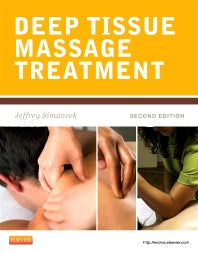Freshly Printed - allow 5 days lead
Couldn't load pickup availability
Deep Tissue Massage Treatment
Get a deeper understanding of the science and techniques of deep tissue massage
Jeffrey Simancek (Author)
9780323077590, Elsevier Health Sciences
Paperback / softback, published 23 May 2012
264 pages, Approx. 230 illustrations (225 in full color)
27 x 18 x 1.8 cm, 0.5 kg
This significantly revised new edition features an easy-to-use format that provides basic theory and assessment of neuromuscular conditions followed by an extensive overview of techniques specific to deep tissue massage Ñ including trigger point therapy, friction techniques, myofascial techniques, and stretching. Step-by-step treatment routines for the 22 most commonly encountered neuromuscular conditions are clearly outlined using detailed descriptions and illustrations side-by-side. Downloadable assessment forms and 90-minutes of video on proper deep tissue massage techniques are included on the companion Evolve website.
1. Theory Theoretical Approach Forces applied to the body The Nature of Tension and Discomfort Emotions and Deep Tissue Approach to Deep Tissue Benefits of Deep Tissue Massage 2. Assessments Postural Assessment Postural Distortions and Compensations Gait Cycle Gait Analysis Functional Assessments Kinetic Chain Protocol Range of Motion 3. Common Approaches Basic Swedish Massage Structural Bodywork Myofascial Approach Trigger Point Therapy Friction Techniques Stretching Putting It All Together 4. Tools and Techniques Principles of Deep Tissue Massage Tools for Deep Tissue 5. Head and Neck Migraines & Headaches (HA) Temporomandibular Joint (TMJ) Disorder Torticollis Whiplash Thoracic Outlet Syndrome (TOS) 6. Shoulder Anatomy of the Shoulder Adhesive Capsulitis Rotator Cuff Injuries 7. Arm and Hand Anatomy of the Arm and Hand Nerve Impingements Epicondylitis; Tendonitis/Tendonosis Carpal Tunnel Syndrome 8. Back and Abdominals Anatomy of the Thoracopelvic Region Postural Distortions Low Back Pain Abdominals Working with Posture 9. Hips and Thigh Muscles of the Hip and Thigh Balancing the Hip Psoas Release Quadriceps Piriformis Patellofemoral Iliotibial Band Disorder 10. Leg Anatomy of the Leg and Foot Sprained/Strained Ankles Shin Splints Plantar Fasciitis
Subject Areas: Complementary medicine [MX], Physiotherapy [MQS]


